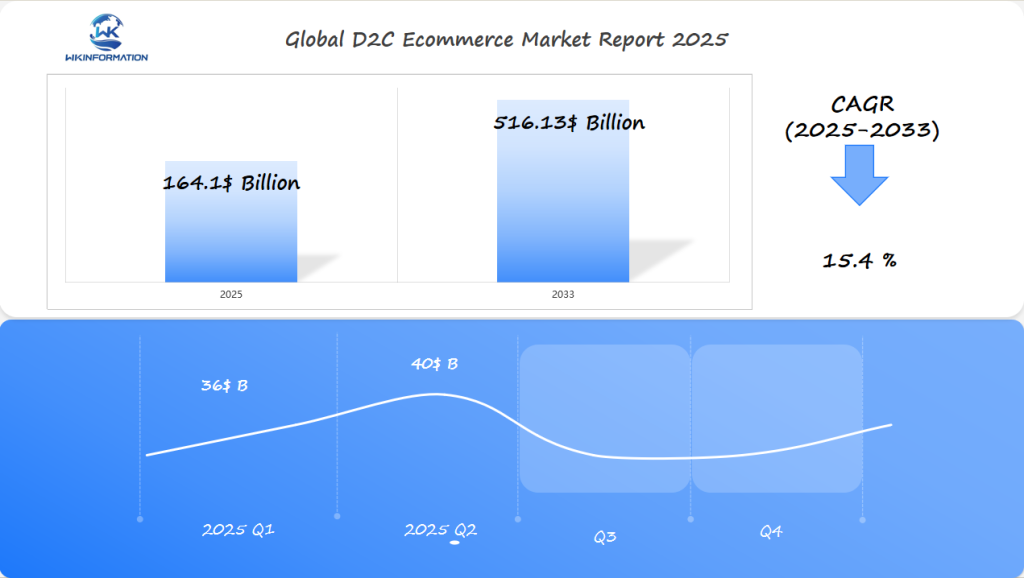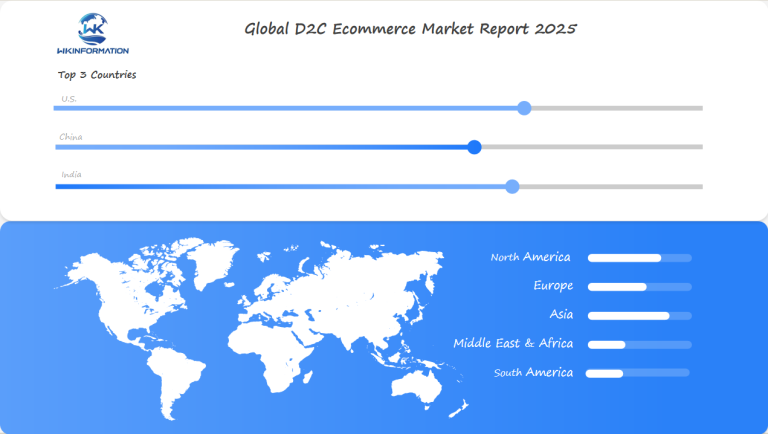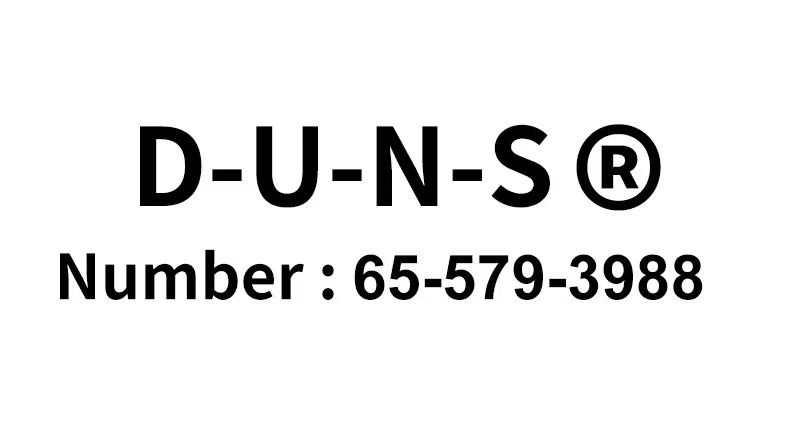D2C Ecommerce Market Projected to Surpass $164.1 Billion by 2025: Trends and Insights from the U.S., China, and India
Explore the booming D2C Ecommerce Market as it reaches new heights, with key trends, growth drivers, and market forecasts. Discover how brands are reshaping retail through direct sales.
- Last Updated:
D2C Ecommerce Market Projections for Q1 and Q2 of 2025
The D2C (Direct-to-Consumer) Ecommerce market is expected to reach $164.1 billion by the end of 2025, growing at a robust CAGR of 15.4% from 2025 to 2033. In Q1 of 2025, the market size is forecasted to be around $36 billion, as many brands launch seasonal promotions and expand their direct-to-consumer channels post-holiday season. By Q2, the market is predicted to rise to approximately $40 billion, driven by continued growth in mobile shopping, improved delivery logistics, and personalized shopping experiences.
The U.S. dominates this sector, with major players like Amazon, Warby Parker, and Glossier scaling their direct sales efforts. China’s market is seeing rapid growth, especially with the younger, tech-savvy population preferring the convenience and price advantages of direct buying. In India, D2C models are booming due to the rise of small businesses and the increasing penetration of smartphones and e-commerce platforms.

Key Takeaways
- D2C ecommerce market expected to reach $164.1 billion by 2025
- Technological innovations driving market transformation
- Direct consumer engagement becoming primary growth strategy
- Significant market potential in U.S., China, and India
- Personalized shopping experiences gaining consumer preference
Upstream and Downstream Factors Influencing the D2C Ecommerce Market
The direct-to-consumer (D2C) ecommerce industry is evolving rapidly, driven by new supply chain strategies and shifting consumer behaviors. Brands are now prioritizing personalized and streamlined shopping experiences.
To stay competitive, brands must prioritize modern D2C supply chain management. This involves exploring innovative approaches to enhance operational efficiency and foster stronger connections with customers.
Supply Chain Innovations in D2C Models
Top D2C brands are using new supply chain strategies:
- Real-time inventory tracking
- Predictive demand forecasting
- Automated fulfillment systems
- Integrated digital platforms
Consumer Behavior Shifts Driving D2C Growth
Consumer wants are changing fast, pushing D2C brands to keep up. Customers now look for:
- Personalized product experiences
- Transparent brand communication
- Seamless digital interactions
- Direct relationship with manufacturers
These big changes help D2C brands build closer ties with customers. They use technology and data to offer great value.
Trends Transforming the D2C Ecommerce Landscape in 2025
The direct-to-consumer (D2C) ecommerce world is changing fast. New tech and what customers want are driving these changes. Brands are now making shopping more personal, efficient, and green.
New trends are changing how brands talk to customers. They use the latest ecommerce tech to offer great value and connection.
Technology Advancements Empowering D2C Brands
New technology is changing the D2C world with tools that make shopping better:
- AI-powered personalization engines
- Augmented reality product visualization
- Advanced data analytics platforms
- Blockchain-enabled supply chain tracking
These tech advances help D2C brands:
- Make shopping super personal
- Improve the customer journey
- Save money
- Keep customers engaged
Sustainable and Ethical Consumption in D2C
More people want to buy things that are good for the planet. They want brands to be open, fair, and green. D2C brands that focus on being green are seen as leaders. They win over customers who care about the planet by being true to their values.
Overcoming Challenges in the D2C Ecommerce Industry
The direct-to-consumer (D2C) ecommerce world is full of challenges for brands wanting to grow fast. These barriers make it hard for new digital businesses to succeed online.
Digital brands face many obstacles when trying to grow. It’s key to understand these challenges to find ways to break into the market.
Overcoming Customer Acquisition Challenges
Getting customers is a big challenge in the D2C ecommerce world. Brands need to find new ways to stand out:
- Leverage targeted social media advertising
- Create engaging content marketing campaigns
- Develop strategic influencer partnerships
- Build authentic brand storytelling
Successful D2C brands know old marketing ways don’t work anymore. Personalization and authentic connections are key to winning and keeping customers.
Addressing Fulfillment and Logistics Hurdles
Ecommerce logistics are a big challenge for D2C brands wanting to grow. They need good systems and planning for efficient order fulfillment.
- Implement advanced inventory management systems
- Optimize shipping and delivery processes
- Develop robust return management protocols
- Invest in technology-driven logistics solutions
Brands that solve these logistics problems can turn them into strengths. This helps them grow in the fast-changing D2C ecommerce world.

Geopolitical Factors Affecting D2C Ecommerce Expansion Globally
The world of D2C ecommerce is changing fast. It’s all because of complex global politics. These changes make it hard for brands to sell across borders.
Brands face many challenges. They must deal with strict rules and trade policies in new markets.
Navigating International Trade Policies
Trade policies are key to D2C success worldwide. Each country has its own rules that can affect sales:
- Tariff structures affecting product pricing
- Customs clearance complexity
- Market access restrictions
Digital Regulation and Data Privacy Challenges
Digital rules are now a big deal for D2C brands wanting to grow globally. Compliance with data privacy laws needs smart tech and legal plans.
| Region | Key Digital Regulation Focus |
| European Union | GDPR Data Protection |
| United States | Consumer Data Privacy Laws |
| Asia-Pacific | Emerging Data Localization Policies |
For D2C brands to grow globally, they must understand and adapt to these changes. They need flexible plans that can keep up with new rules.
Segmenting the D2C Ecommerce Market: Key Product Categories and Niches
The direct-to-consumer (D2C) ecommerce market has seen big changes. New brands are changing product categories and finding special niches. D2C market segmentation is key for brands wanting to reach consumers directly and offer personal experiences.
- Digitally Native Vertical Brands (DNVBs)
- Established Brands adopting D2C strategies
Emerging D2C Categories in Fashion and Beauty
The fashion and beauty sectors are leading in D2C innovation. Brands use digital platforms to offer tailored shopping experiences that traditional stores can’t. Personalized skincare, custom clothes, and unique beauty brands are thriving.
Specialized D2C Niches in Home and Lifestyle
Home and lifestyle products show great D2C opportunities. Brands are making special items for specific needs, like green home goods and new wellness products.
| Product Category | Market Potential | Key Differentiators |
| Sustainable Home Goods | High Growth | Eco-friendly Materials |
| Personalized Wellness Products | Rapid Expansion | Customized Solutions |
| Smart Home Accessories | Emerging Market | Technology Integration |
These niche markets show the strength of focused D2C strategies. They help brands build strong connections with consumers through unique products and personal experiences.
Applications Driving the D2C Ecommerce Growth in Diverse Sectors
The direct-to-consumer (D2C) ecommerce model is changing how businesses meet customers in many fields. It’s making market dynamics different by cutting out middlemen. This leads to more personal experiences for shoppers.
New D2C ways are changing how companies make products, market them, and talk to customers. Brands use online platforms to connect directly with buyers. This breaks down old retail walls.
D2C Innovations in Food and Beverage Industry
Food and drink D2C brands are leading in new ways to talk to customers. They’re coming up with special plans like:
- Personalized nutrition plans
- Subscription-based meal kits
- Direct farm-to-table products
- Custom dietary supplement programs
Startups like Thrive Market and Hungryroot have made D2C work. They give tailored food right to your door.
D2C Disruption in Electronics and Tech Gadgets
Tech gadgets D2C brands are changing how we get new tech. They offer the latest tech straight to us online. These companies are:
- Speeding up product making
- Lowering costs by cutting out middlemen
- Offering quick customer help
- Releasing new products first
Brands like Anker and Wyze have seen big wins. They focus on what customers want and new tech.
A Global Overview of the D2C Ecommerce Market
The global D2C market is changing how brands reach out to customers worldwide. Fast digital changes and new consumer wants have made this market grow fast.
With cross-border ecommerce, brands can now reach more people globally. New strategies help companies go beyond old retail limits and connect directly with customers everywhere.
Regional Market Sizes and Growth Rates
Different parts of the world show different things in the D2C ecommerce world:
- North America is ahead with its big market
- Asia-Pacific is growing really fast
- European markets have smart consumer interactions
Each region grows at its own pace, with new markets offering big chances. The United States is a key player, seeing huge jumps in direct sales to consumers.
Cross-Border D2C Opportunities and Challenges
Brands in cross-border ecommerce face both challenges and chances. Important things to think about include:
- Localizing digital platforms
- Getting to know local consumer habits
- Handling international shipping issues
- Adjusting payment systems
Being strategic is key for success in the global D2C market.

The U.S. D2C Ecommerce Market: Digital Transformation and Consumer Behavior
The US D2C market has undergone a significant transformation, reshaping the way we shop and interact with brands. This year, 111 million shoppers will represent 40% of the population. The direct-to-consumer industry is rapidly expanding.
Digital transformation is crucial for brands seeking to connect with consumers directly. The traditional retail model is declining. Instead, we are witnessing a rise in personalized and convenient shopping experiences that cater to our preferences.
Key Players Driving Innovation
Some brands have changed the US D2C market with smart digital moves:
- Warby Parker: Introduced virtual try-on for glasses
- Casper: Made buying mattresses online easy
- Dollar Shave Club: Changed how we get grooming products
Consumer Expectations Reshaping the Market
Today’s shoppers want easy, personalized, and tech-rich experiences. The US D2C market meets these needs by offering:
- Smooth shopping across all channels
- Products tailored just for you
- Clear stories from brands
The US D2C market’s future is in understanding what we want. It will use digital strategies to build strong, personal bonds between brands and us.
China's Role in D2C Ecommerce Growth: Market Expansion and Technological Innovation
The China D2C market is a huge force in global ecommerce. It’s changing the game with fast growth and new ideas. Chinese brands are leading the way in digital commerce, using smart strategies and the latest tech.
Chinese D2C brands are using their strong manufacturing and digital skills to reach out to the world. The APAC region is growing fast, showing big market hopes.
The Rise of Chinese D2C Brands in Global Markets
Chinese companies are making significant changes to the global ecommerce landscape:
- They are rapidly expanding into new markets.
- They are developing high-quality mobile shopping websites.
- They are leveraging social media as a sales channel.
- They are providing live shopping experiences.
Technological Advancements Driving China’s D2C Sector
Ecommerce tech in China is always getting better. New things include:
- AI that makes shopping more personal
- Easy ways to pay across borders.
- Better ways to get and send packages.
- Tools that translate and adapt for different places.
As Chinese D2C brands grow worldwide, they’re setting new standards. They’re leading in digital commerce innovation and connecting with customers in new ways.
India's Booming D2C Ecommerce Market: Evolving Consumer Preferences
The India D2C market is booming like never before. This is thanks to tech advancements and changing consumer habits. Digital transformation has opened up big opportunities for brands that sell directly to consumers.
Several factors are driving the growth of the India D2C market:
- Rapid internet penetration in urban and rural regions
- Increasing smartphone adoption
- Growing digital literacy
- Rising disposable incomes among young consumers
Factors Driving D2C Growth in India
Consumer preferences are changing fast. Young Indians want unique, personalized products that show off their individuality. The Indian FMCG sector has responded by creating new direct-to-consumer strategies.
Digital platforms have made it easier for small brands to reach customers. Millennials and Gen Z consumers love brands that offer unique, customized experiences. These are things traditional stores can’t provide.
Challenges and Opportunities for D2C Brands in India
D2C brands face many challenges, including:
- Diverse regional consumer preferences
- Logistics infrastructure limitations
- Competitive pricing pressures
- Customer acquisition costs
But there’s still a lot of room for growth. Brands that invest in tech, understand local tastes, and offer smooth online experiences can grab a big share of the market.
Looking Ahead: The Future of D2C Ecommerce
The world of direct-to-consumer (D2C) ecommerce is changing fast. New technologies and what customers want are leading the way. For brands to grow, knowing these trends is key.
New trends are making shopping more personal and easy. The old way of retail is changing. Technology is key in connecting brands with their audience.
Emerging Technologies Shaping D2C Experiences
New tech is changing the D2C world. Some big changes include:
- Artificial Intelligence for personalized recommendations
- Augmented Reality (AR) for virtual product trials
- Voice commerce integration
- Advanced data analytics for consumer insights
Predicted Market Shifts and Consumer Predictions
Customers want more from brands. They want:
- Products that really fit them
- Stuff that’s good for the planet
- Shopping that’s smooth across all platforms
- Brands that are open and honest
| Technology | Impact on D2C | Consumer Expectation |
| AI Personalization | Enhanced User Experience | Tailored Product Recommendations |
| AR Shopping | Virtual Product Interaction | Immersive Shopping Experience |
| Voice Commerce | Simplified Purchasing | Hands-Free Shopping |
By using new tech and listening to what customers say, D2C brands can lead in digital shopping.
Competitive Analysis in the D2C Ecommerce Market: Key Players and Strategies
The D2C market is always changing. Brands are always finding new ways to get ahead. Big names and new players are changing how we shop online with fresh ideas.
Key Players:
-
Warby Parker – United States
-
Shopify – Canada
-
Boll and Branch – United States
-
Everlane – United States
-
Zalando – Germany
-
Walmart – United States
-
Amazon – United States
-
Nike – United States
-
Apple – United States
-
Glossier – United States
Top D2C brands are using smart ways to stand out. They focus on a few key things:
- Personalized customer experiences
- Advanced digital marketing techniques
- Seamless omnichannel integration
- Innovative product development
Overall
| Report Metric | Details |
| Report Name | Global D2C Ecommerce Market Report |
| Base Year | 2024 |
| Segment by Type |
· Online Store · Mobile App · Social Media · Marketplaces |
| Segment by Application |
· Millennials · Generation X · Generation Z · Baby Boomers |
| Geographies Covered |
· North America (United States, Canada) · Europe (Germany, France, UK, Italy, Russia) · Asia-Pacific (China, Japan, South Korea, Taiwan) · Southeast Asia (India) · Latin America (Mexico, Brazil) |
| Forecast units | USD million in value |
| Report coverage | Revenue and volume forecast, company share, competitive landscape, growth factors and trends |
The D2C impact has changed how brands reach out to customers worldwide. Now, almost two-thirds of shoppers buy directly from brands. This big change is more than just a trend; it’s a new way for brands and customers to connect.
Digital tools have let brands offer more personalized experiences. Companies like Warby Parker and Dollar Shave Club have shown how D2C can shake up markets. Their success shows how brands can use data to build strong bonds with their audience.
For the future, brands should focus on new tech and putting customers first. Successful D2C brands will offer smooth online experiences, care for the planet, and be open with their customers. They need to use advanced analytics, personalize their offerings, and have flexible supply chains to stay ahead.
As D2C ecommerce grows, brands that quickly adapt and focus on real customer connections will do well. The future is for those who mix the latest tech with genuine customer interaction, offering more than just products.
Global D2C Ecommerce Market Report (Can Read by Free sample) – Table of Contents
Chapter 1: D2C Ecommerce Market Analysis Overview
- Competitive Forces Analysis (Porter’s Five Forces)
- Strategic Growth Assessment (Ansoff Matrix)
- Industry Value Chain Insights
- Regional Trends and Key Market Drivers
- D2C Ecommerce Market Segmentation Overview
Chapter 2: Competitive Landscape
- Global D2C Ecommerce Players and Regional Insights
- Key Players and Market Share Analysis
- Sales Trends of Leading Companies
- Year-on-Year Performance Insights
- Competitive Strategies and Market Positioning
- Key Differentiators and Strategic Moves
Chapter 3: D2C Ecommerce Market Segmentation Analysis
- Key Data and Visual Insights
- Trends, Growth Rates, and Drivers
- Segment Dynamics and Insights
- Detailed Market Analysis by Segment
Chapter 4: Regional Market Performance
- Consumer Trends by Region
- Historical Data and Growth Forecasts
- Regional Growth Factors
- Economic, Demographic, and Technological Impacts
- Challenges and Opportunities in Key Regions
- Regional Trends and Market Shifts
- Key Cities and High-Demand Areas
Chapter 5: D2C Ecommerce Emerging and Untapped Markets
- Growth Potential in Secondary Regions
- Trends, Challenges, and Opportunities
Chapter 6: Product and Application Segmentation
- Product Types and Innovation Trends
- Application-Based Market Insights
Chapter 7: D2C Ecommerce Consumer Insights
- Demographics and Buying Behaviors
- TargetAudience Profiles
Chapter 8: Key Findings and Recommendations
- Summary of D2C Ecommerce Market Insights
- Actionable Recommendations for Stakeholders

Access the study in MULTIPLEFORMATS
Didn’t find what you’re looking for?
TALK TO OUR ANALYST TEAM
Need something within your budget?
NO WORRIES! WE GOT YOU COVERED!
Call us on: +1-866-739-3133
Email: infor@wkinformation.com
What is the projected market size for D2C ecommerce by 2025?
The Direct-to-Consumer (D2C) ecommerce market is expected to hit $164.1 billion by 2025. This growth is mainly driven by the United States, China, and India.
How are D2C brands transforming traditional retail models?
D2C brands are changing retail by connecting directly with customers. They offer personalized experiences and use digital tech to cut out middlemen.
What technological innovations are driving D2C ecommerce growth?
Key innovations include:
- AI for personalization
- Augmented reality for product views
Other important technologies are:
- Blockchain
- Advanced mobile platforms
What are the main challenges facing D2C ecommerce businesses?
D2C businesses face challenges like finding customers in a crowded space. They also deal with complex logistics, cross-border rules, and affordable marketing.
How are consumer preferences changing in the D2C market?
Consumers want personalized products and brands that are sustainable and ethical. They also look for easy shopping and direct connections with companies.
Which product categories are most successful in D2C ecommerce?
Fashion, beauty, food, electronics, home goods, and lifestyle products are the top categories in D2C. Brands are focusing on offering unique products to differentiate themselves from traditional stores.
What role do emerging markets play in D2C ecommerce growth?
India and China are experiencing rapid growth in D2C ecommerce. This growth can be attributed to factors such as increased internet usage, rising incomes, and a growing demand for personalized products.
How are geopolitical factors impacting D2C ecommerce?
Trade policies, digital laws, data privacy, and cross-border agreements affect D2C brands’ global growth. They impact managing international operations.
What future trends are expected in D2C ecommerce?
Trends include hyper-personalization and more AI use. Virtual and augmented reality, voice commerce, and a focus on sustainability are also expected.
How are successful D2C brands differentiating themselves?
Successful D2C brands innovate, target marketing, build communities, and communicate openly. They create unique experiences that connect with specific groups.


